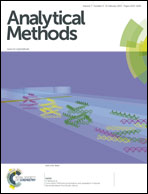An electrochemical sensing method for the determination of levodopa using a poly(4-methyl-ortho-phenylenediamine)/MWNT modified GC electrode†
Abstract
A glassy carbon electrode (GCE) modified with poly 4-methyl-ortho-phenylenediamine (4-MoPD) and multi-wall carbon nanotubes (MWNTs) was used for selective and sensitive voltammetric determination of levodopa (L-Dopa) in phosphate buffer solution of pH 7.0. The mechanism of electrooxidation at this modified electrode was a purely diffusion-controlled reaction involving one-electron in the rate-determining step with a transfer coefficient (α) of about 0.60. The modified electrode exhibits good catalytic activity for oxidation of L-Dopa with high sensitivity (0.796 μA μmol−1), in a wide concentration range, (4.16 × 10−7–4.00 × 10−4 mol L−1), and a detection limit of 1.01 × 10−7 mol L−1. The anodic oxidation peak potential of L-Dopa (in PBS, pH 7.0) at the surface of the proposed modified electrode occurred at low overpotential (0.22 V vs. Ag/AgCl) and the oxidation current is about 16 times that of a bare GCE. Furthermore, the modified electrode can separate the signals of ascorbic acid (AA) and L-Dopa in a mixed solution with a peak separation of 183 mV. The present biosensor has been applied successfully for determination of low concentrations of L-Dopa in a pharmaceutical drug.


 Please wait while we load your content...
Please wait while we load your content...